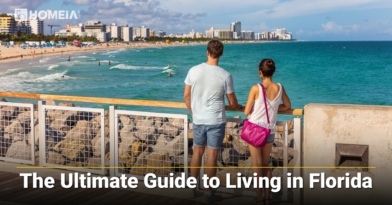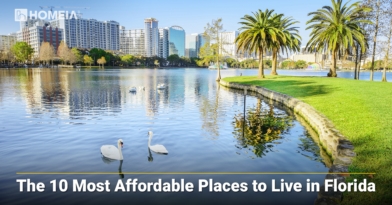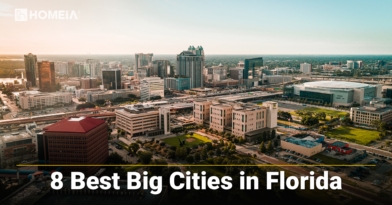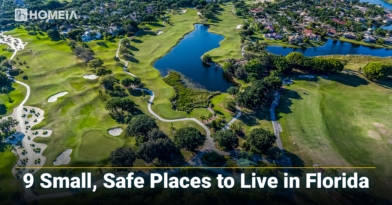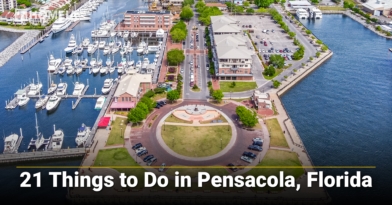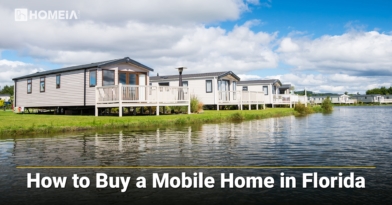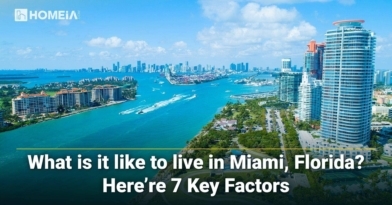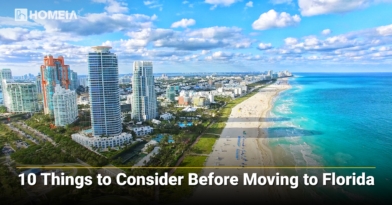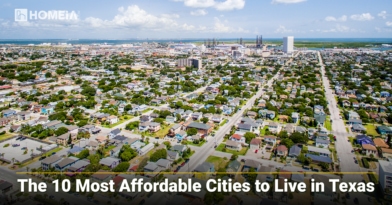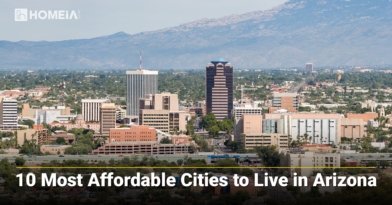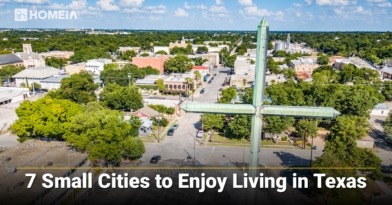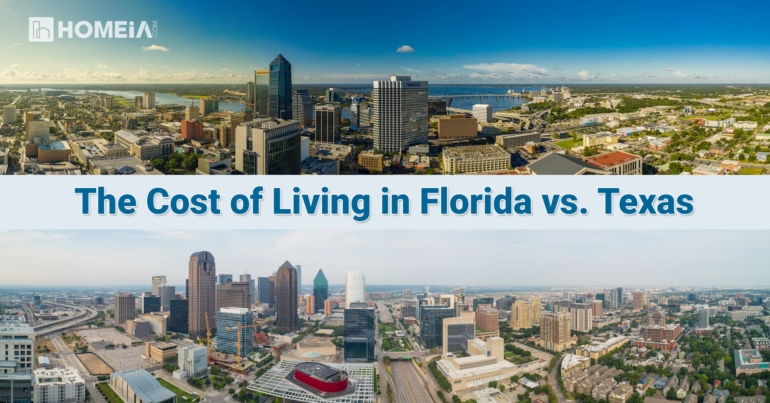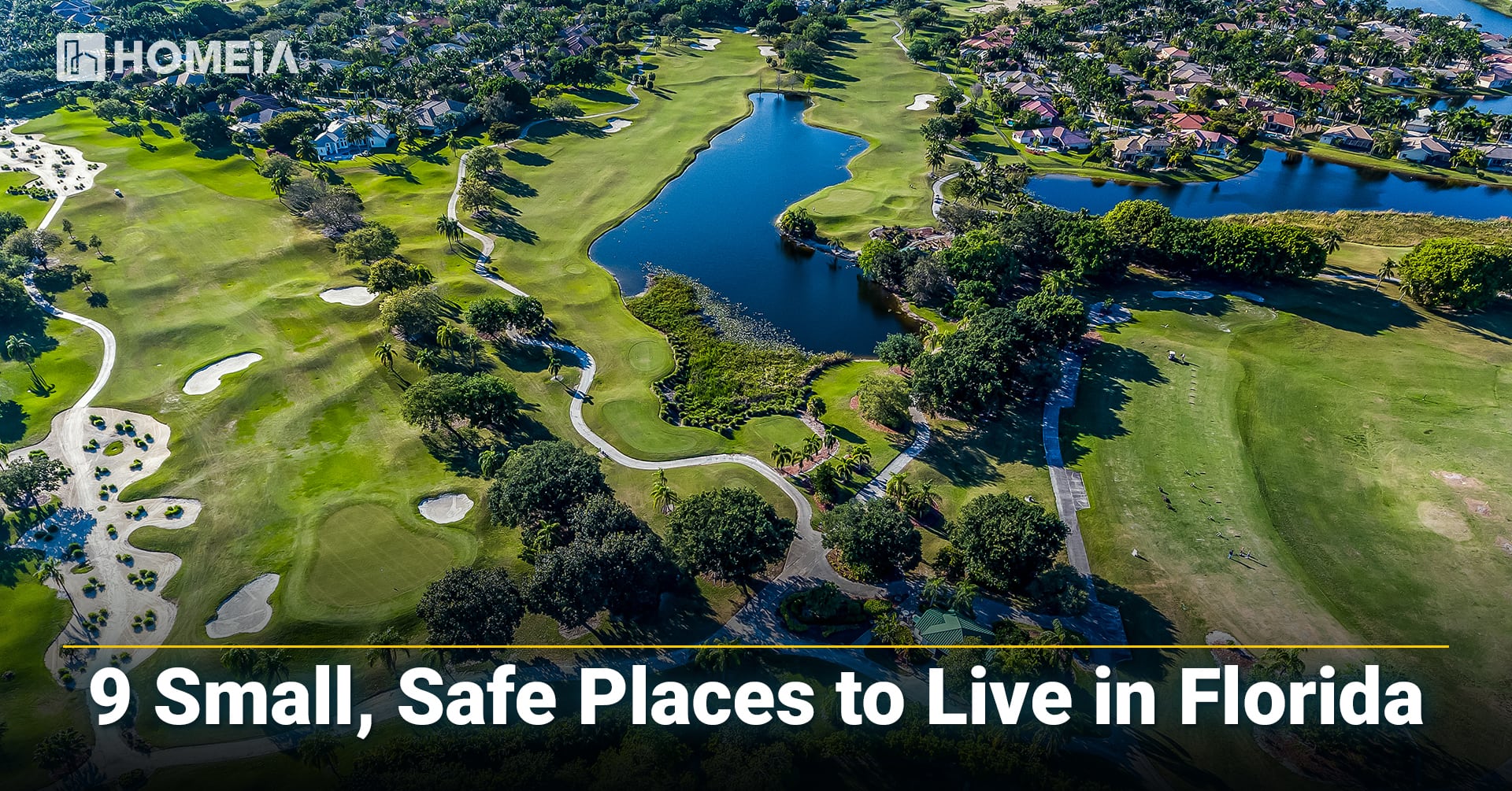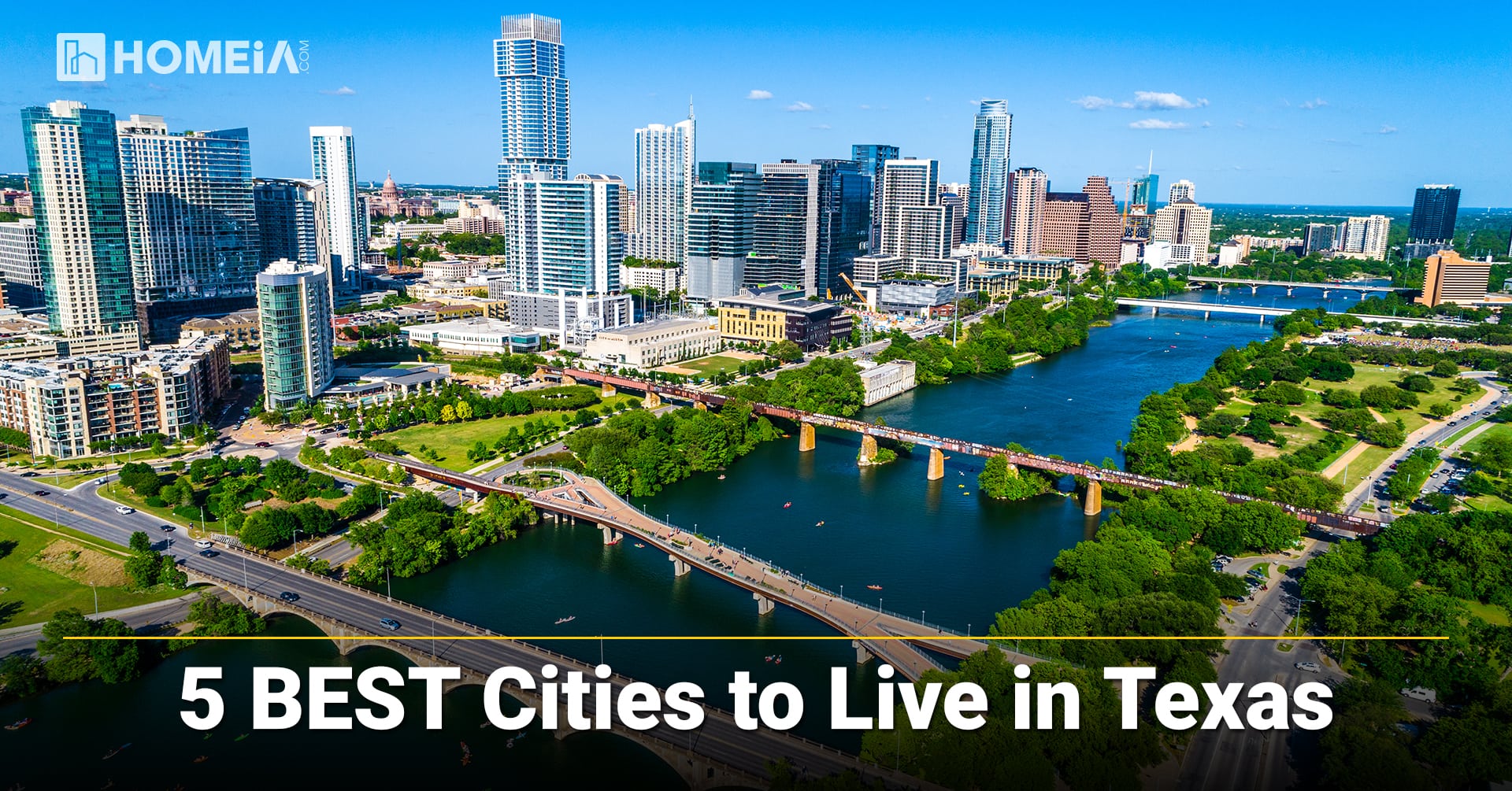The 8 Best Places to Live in Florida For Retirees in 2024
- Author:by The HOMEiA Team
- Category: City Living Guide
Many people know that Florida is a great place to retire. There are beaches, warm weather all year long, and best of all – there’s no snow! All these factors plus more make it a great place to live out the best years of your life.
The places described below have certain characteristics in common, so here are a few general points that cover all of Florida:
- Taxes: One way that Florida is great is that it has no state income tax. If you compare that to the national average (4.6%) you wind up saving tons of money in the long run. In addition to that, property taxes are low as well. The average effective rate is 0.83% of property values. On top of that, the state sales tax is only 6.0%. Some localities add their own tax on top of that, resulting in an average combined rate of 7.05% which is not expensive at all compared to some other states.
- Climate: The average climate in the north and central Florida is humid subtropical. Much of South Florida is tropical in nature and rarely falls below freezing temperatures. May through October is hurricane season so many areas, particularly on the coast, experience lots of rain and thunderstorms during those months. Additionally, Florida is the lightning capital of the United States and contains 17 of the top 30 cities with the most lightning strikes. Don’t let this deter you though! It’s extremely rare for lightning to harm anyone.
Each area below is assigned a Score. This number (out of 100) provides an overall assessment of the city’s appeal in regards to things retirees might be interested in.
It’s important to keep in mind that not every place on the list is affordable to buy homes in. Remember that this is normal when talking about wealthy retiree communities. Even so, we have presented options that will fit a variety of budgets and needs.
It’s common knowledge that deciding where to move can be challenging, not to mention the actual move! There are plenty of cities and towns that have pros and cons. Be sure to check out our list of the best retiree areas in Florida to help you narrow down the best options depending on what is the most important to you.
Below are the 8 best places to retire in Florida in 2024. The most affordable cities are listed first even though the ranks and index scores are assigned based on a larger set of characteristics that we have reviewed.
Table of Contents:
1. Clearwater
HOMEiA Score: 77/100
- Population: 117,292 | Rank Last Year: #8
- Cost of Living: 0.9% above the U.S. national average
- Home price to income ratio: $225,600/$50,335 = 4.48 (buying homes is slightly expensive)
- Income to rent ratio: $50,335/$14,004= 3.59 (renting homes is affordable)
Clearwater is the most affordable places to retire in Florida. This city is located on the coast of west Florida near the Gulf of Mexico and Tampa Bay. This area contains beautiful sunsets and water views as one of the most popular beach and vacation destination for Florida residents.
There are plenty of roads that allow residents to access highways that lead them to other larger cities such as Miami and Orlando. There are smaller airports as well as a large international airport located just outside of Clearwater in Tampa.
a. Size and Population
Clearwater’s population is 116,946 as of 2019. This number occupies roughly 36 square miles of land which puts the population density around 4,500 per square mile.
The population of this city grew by 7.2% between April of 2010 and July of 2019 which is great in terms of population growth. This is a great sign and means that there are plenty of opportunities for new developments and refurbishments in the city (U.S. Census Data). Another great fact is that Clearwater’s 65-and-over population is about 22.5%.
b. Median Income, Cost of Living and Housing Market Characteristics
The numbers below show the median income, cost of living and annual spending on housing for owned and rented properties in Clearwater.
CLEARWATER MEDIAN HOUSEHOLD INCOME (2016-2022): $50,335
Clearwater Cost of Living
- 2% Below the U.S. National Average
- On Par with St. Petersburg, Florida
- 47% Lower than New York City, New York
- 8% Lower than Chicago, Illinois
Clearwater Housing Costs
| Median Home Value | Annual Spend for Homeowners | Annual Spend for Renters (Rent & Utilities) |
| $225,600 | $18,000 | $14,004 |
The home price to income ratio of houses in Clearwater is about 4.24. This is based on the median home price of $206,300 and a median household income of $48,691. This is slightly above the US average which means it’s slightly expensive to buy homes in the area. On the other hand, Clearwater shows an income to rent ratio of 3.72. This is based on a median household income of $48,691 and an annual spend of $13.104. This means that it is affordable to rent properties in this area.
It’s important to mention that in Clearwater, 58.5% of residents own their homes which is good if you are looking to purchase property over renting.
Pros and Cons of Living in Florida
If you’ve decided to make Florida your new home, you’re in luck – it’s a big and varied place, with something for all ages, family dynamics and budget. Continue reading as we dive into some notable Pros and Cons about the state itself, the top cities to live in across a variety of categories, and…
Top Neighborhoods in Clearwater, FL:
- Old Clearwater Bay (Home Value Range: $150,000 to $1.5 million)
This area is great for those looking for medium-sized family homes and waterfront views. - Sunset Lakes Estates (Home Value Range: $150,000 to $750,000+)
These homes are located inland and has a variety of large and small homes. - Sunny Grove Mobile Park (Home Value Range: $75,000 to $600,000+)
This area is great for those looking to join fun activities like bingo and barbeques. - Greenbriar Club (Home Value Range: $150,000 to $400,000+)
Just minutes from the beach, this neighborhood offers easy access to major highways.
c. Unique Attributes and Lifestyle
- Beaches and sunsets. The beaches are known to have beautiful “clear water,” just as the name says so be sure to check them out all year round as the water rarely gets too cold!
- Clearwater Marine Aquarium. Visit one of the most popular aquariums in Florida for a fun day out. This attraction is great for those of any age, including the grandkids!
- Downtown Clearwater. The downtown area welcomes over two million visitors each year but don’t worry – there’s room for everyone! Check out unique shopping and dining options if you’re itching for a night out.
Moccasin Lake Nature Park. This nature area is great for those looking for a large showcase of native plant and animal species. Nature-lovers will be in awe over this awesome park that rescues and rehabilitates birds, reptiles, and other animals.
d. Education
Clearwater is home to St. Petersburg College and The University of South Florida, located just under an hour away. Between 2015 and 2019, the high school graduation rate in Clearwater was above the U.S. national average of 88%. The proportion of adults above 25 who’ve earned a college degree was slightly below the national average of approximately 32%.
e. Healthcare and Safety
Morton Plant Hospital is over 100 years old and has about 600 beds. There are plenty of doctors and specialists who work in more than 50 specialty areas. According to HealthGrades.com, over 82% of patients would recommend this location. Be sure to do your own research about the medical facilities in the area depending on your needs! Remember, your doctor can always recommend facilities before you move.
Clearwater has 4.02 violent crimes per 1,000 residents which is slightly above Florida’s statewide median rate of 3.78 and the U.S. national median rate of 4.00. This means that the area is generally safe but does contain some crime- like any city.
It also has 24.03 property crimes per 1,000 residents which is above Florida’s statewide median of 21.46 and the U.S. national median of 21.
Remember, large cities will always have crime but do not let this sway you too much! Be smart about your home and consider additional safety measures, like a security system if needed.
Recommended for you
2. Palm Coast
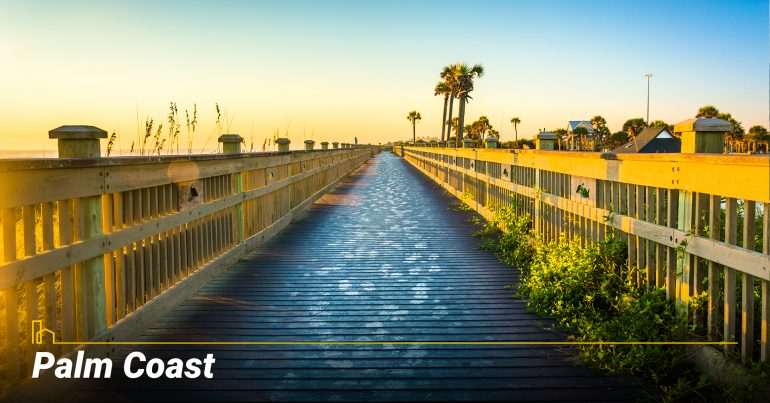
HOMEiA Score: 85/100
- Population: 89,258 | Rank Last Year: #5
- Cost of Living: 3.1% above the U.S. national average
- Home price to income ratio: $226,100/$57,872 = 3.91 (buying homes is affordable)
- Income to rent ratio: $57,872 /$16,488 = 3.51 (renting homes is affordable)
Located about an hour south of Jacksonville on the east coast of the state, Palm Coast is a great coastal town that plenty of retirees call home. There are plenty of access points to major highways and a popular airport located in Daytona Beach.
Many are happy to know that a brand-new Buc-ee’s location is located just 20 minutes south of Palm Coast! This massive, beaver-themed gas station is a favorite for those looking for a fun road-side activity.
a. Size and Population
The population of Palm Coast is just under 90,000 and has an area of over 96 square miles. The means that the population density is about 945 per square mile according to an estimate from 2019. Palm Coast’s population grew by 19.4% between April 2010 and July 2019 which is above the overall U.S. rate of 6.3%
In Palm Coast, 28.2% of the population is over 65 years of age. This is just about on par with Florida (26.8%) but high compared to the U.S. national average (16.5%).
b. Median Income, Cost of Living and Housing Market Characteristics
The numbers below show the median income, cost of living and annual spending on housing for owned and rented properties in Palm Coast.
PALM COAST MEDIAN HOUSEHOLD INCOME (2016-2022): $57,872
Palm Coast Cost of Living
- 4% Below the U.S. National Average
- 3% Higher than Jacksonville, Florida
- 49% Lower than New York City, New York
- 10% Lower than Chicago, Illinois
Palm Coast Housing Costs
| Median Home Value | Annual Spend for Homeowners | Annual Spend (Rent & Utilities) |
| $226,100 | $16,020 | $16,488 |
The home price to income ratio in Palm Coast is 3.85, based on the median home price of $209,300 and a median household income of $54,360. Therefore, it is affordable to buy homes in the area as the US National Average is 4.0.
If you’re more interested in renting a property, the income to rent ratio is 3.49. This is based on a median household income of $54,360 and an annual spend of $15,576. Therefore, it is affordable to rent properties in Palm Coast.
In this rare, 74.3% of residents own their homes. With many large neighborhoods and beautiful homes, there’s plenty of lovely scenic walks you can take when the weather gets cooler (typically November through February)!
10 Most Affordable Places to Live in Florida in 2024
With year-round warm weather and over 8,000 miles of coastline, it’s no wonder Florida is a prime vacation destination. Filled with wildlife, beaches, lakes, rivers, amusement parks, diverse entertainment options and much more, the population of Florida is growing with people that want to call Florida “home,” soak up the sun…
Top Neighborhoods in Palm Coast, FL:
- Palm Harbor (Home Value Range: $150,000 to $450,000)
This neighborhood is in a highly desirable area with a variety of homes. Most have canal views so don’t forget your binoculars, so you don’t miss the manatees! - Cypress Knoll (Home Value Range: $525,000 to $700,000)
This area is found in central Palm Coast and is near the Cypress Knoll Golf Club. This is great for those who are looking for a new hobby! - Lehigh Woods (Home Value Range: $225,000 to $475,000)
This community features a park with a public playground, basketball courts and a skate park – there are plenty of things for the grandkids to do year-round! - Quail Hollow (Home Value Range: $225,000 to $425,000)
This neighborhood, located near Route 100, has been growing rapidly in recent years. It’s great for anyone looking to grow with their new community. - Matanzas Woods (Home Value Range: $225,000 to $450,000)
This area is the closest neighborhood to St. Augustine, with tons of single-family homes.
c. Unique Attributes and Lifestyle
Palm Coast has beautiful water-views and is great for those looking to experience the beach and shore all throughout the year! The area was originally mostly swampland and pine trees but has since grown to house lovely communities with tons of waterfront homes. Don’t worry though, you’ll still be able to spot the occasional alligator!
- Parks. Waterfront Park, Varn Park, Palm Coast Linear Park and James F. Holland Memorial Park all have beautiful nature trails and sights ready to be explored for those of all ages.
- Golfing. The Palm Harbor Golf Club is great for those looking to practice their swing. It’s also located off the Palm Coast Marina Canals.
- St. Augustine. This historic town is only a 45-minute drive north of Palm Coast. It was founded in 1565 and is the oldest continuously inhabited city in the U.S. – great for history-lovers! Be sure to watch the cannon-firing demonstration when visiting the fort in the historic area of St. Augustine.
- Beaches. There are plenty of amazing beaches up and down Palm Coast. In general, the beaches are not overrun with tourists and are typically clean and quiet as many legitimate tourists choose to visit Daytona Beach instead. This keeps Palm Coast mostly clean and quiet.
d. Education
Palm Cost is very close to Daytona State College and Flagler Technical College – both great options for those looking for small programs and certification options. Feel free to sign up for courses as well, as there are plenty of offerings in categories such as art and music. Rediscover your love of ceramics or learn a new skill when you have free time.
Between 2015 and 2019, the high school graduation rate in Palm Coast was above the U.S. national average of 88%. About 32% of palm coast residents hold a college degree.
e. Healthcare and Safety
There plenty of healthcare facilities located in Palm Coast. AdventHealth Palm Coast is a great option for those looking for a variety of care options and great doctors! According to HealthGrades.com, 65% of patients would recommend this location for their medical procedures and general care.
Palm Coast has 1.65 violent crimes per 1,000 residents, which is significantly lower than Florida’s statewide median rate of 3.78 and the U.S. national median rate of 4.00. It also has 9.53 property crimes per 1,000 residents, which is also significantly lower than Florida’s statewide median of 21.46 and the U.S. national median of 21.00! This is great news for those who are prioritizing safety in their new home.
Recommended for you
3. Venice
HOMEiA Score: 90/100
- Population: 25,463 | Rank Last Year: #2
- Cost of Living: 2.9% above the U.S. national average
- Home price to income ratio: $282,700/$61,953 = 4.56 (buying homes is expensive)
- Income to rent ratio: $61,953/$15,300= 4.05 (renting homes is affordable)
Located on the west coast of Florida, Venice is a little over an hour’s drive south of Tampa. There are plenty of highways and airports that give access to major roads and airlines including Venice Municipal Airport and the Tampa International Airport, a major airline hub.
a. Size and Population
The population of Venice is 23,985 and has an area of 16.7 square miles. The population density is 1,591 per square mile according to data from 2019. Population growth in Venice increased to 15.3% from April 2010 through July 2019. This is above the national average.
Venice is home to many retirees, with 62.6% of the population being over 65 years of age. This is extremely high compared to the U.S. This is awesome news for those who are looking to move to an area where they don’t know anyone! There will be plenty of time to meet new friends with tons of activities to get to know the other retirees in this area.
In comparison, only 6.2% of the population of Venice is below 18 years of age — a much lower percentage than Florida (16.8%) and the U.S. overall (22.3%). Even so, the Venice High School football team is one of the best teams in the state – so don’t forget to support your local players!
The population in Venice has a much higher percentage of Caucasian inhabitants (95.1%), which is 25% higher than the US national average (76.3%) and 23% higher than the Florida average (77.3%).
b. Median Income, Cost of Living and Housing Market Characteristics
The numbers below show the median income, cost of living and annual spending on housing for owned and rented properties in Venice.
VENICE MEDIAN HOUSEHOLD INCOME (2016-2022): $61,953
Venice Cost of Living
- 1% Above the U.S. National Average
- 1% Higher than Tampa Bay, Florida
- 46% Lower than New York City, New York
- 5% Lower than Chicago, Illinois
Venice Housing Costs
| Median Home Value | Annual Spend for Homeowners | Annual Spend (Rent & Utilities) |
| $282,700 | $20,196 | $15,300 |
The home price to income ratio of Venice is 4.2. This is based on the median home price of $252,200 and a median household income of $60,086. The U.S. average is 4.0 which means it is slightly expensive to buy homes in the area. On the other hand, Venice shows an income to rent ratio of 3.7 so it is affordable to rent properties in the area.
In Venice, 75.8% of residents own their homes.
The 8 Largest Cities in Florida
For each of these communities, we assign a HOMEiA Score, which provides an overall assessment – based on affordability, lifestyle, healthcare, education and other relevant factors – of the city’s appeal as a place to call home…
Top Neighborhoods in Venice, FL:
- The Grand Palm (Home Value Range: $300,000 to $1 million)
This is a great area for families looking to move then retire in the area. - Venice Farms (Home Value Range: $200,000 to $3+ million)
This area is great for large properties used for farmlands and open fields. Check out the area if you’re looking to be far away from your neighbors and live in a peaceful location. - The Island of Venice (Home Value Range: $100,000 to $700,000+)
A popular area where many special events take place. - Venice Golf and Country (Home Value Range: $175,000 to $800,000)
This is a private neighborhood situated on a country club, so make sure to check out the day pass option, or heck – even join the club!
c. Unique Attributes and Lifestyle
Venice is a beautiful hidden paradise on the west coast of Florida with tons of fun things to do. Here are a few things this area is known for:
- Leisure activities. This area has a large retirement community, and its many activities include golfing, tennis and horseback riding. These kinds of activities are perfect for those who are on the lookout for active hobbies that can fit into the retiree lifestyle.
- Shark Teeth. Yes, it’s true! Venice Beach is world-famous for the abundance of shark teeth that wash up on the shore each year. It is also a certified Blue Wave Beach. This means that human health and environmental protection are a priority in the area, and the beaches will always be incredibly clean. Your grandkids won’t be able to handle their excitement each time you embark on a new “shark tooth hunt!”
- Historic downtown area. Venice also has a lovely and historic downtown area featuring beautiful northern Italian architecture reminiscent of the Italian city of the same name.
- Wildlife. It’s not uncommon to see plenty of different types of wildlife in the town of Venice. Nesting sea turtles are common in this area and are often spotted in large numbers between May and October. If you see a nest, don’t disturb the babies!
d. Education
New College of Florida, Ringling College of Art and Design, and a few major public university campuses are located about 45 minutes north of Venice in the close city of Sarasota.
If you are prioritizing learning something new after your move, this area might not be the best option. Although there might be smaller studios or private teachers in the area, there are no convenient formal education options in this area.
Between 2015 and 2019, the high school graduation rate in Venice was significantly above the U.S. national average of 88%.
e. Healthcare and Safety
Venice has many small medical offices and one major local hospital. Venice Regional Bayfront Health offers plenty of care options. According to HealthGrades.com, over 50% of patients would recommend this location.
Venice has one violent crime per 1,000 residents which is significantly below Florida’s statewide median rate of 3.78 and the U.S. national median rate of 4.00. It also has 11.88 property crimes per 1,000 residents, which is also significantly below Florida’s statewide median of 21.46 and the U.S. national median of 21.00. Another town great for those prioritizing safety!
It is to be noted that while Venice seems to have a higher crime rate than some of the cities we list, the overwhelming majority of incidents are property crimes. Violent crimes are only 7.8% of the total number. Property crimes are more prevalent in wealthy communities, but they are usually preventable! Invest in a security system and maybe even some cameras. This helps to deter anybody looking to cause harm!
Recommended for you
4. New Smyrna Beach
HOMEiA Score: 84/100
- Population: 30,142 | Rank Last Year: #6
- Cost of Living: 7.1% above the U.S. national average
- Home price to income ratio: $272,100/$61,885 = 4.40 (buying homes is expensive)
- Income to rent ratio: $61,885/$15,120 = 4.09 (renting homes is affordable)
This area is perhaps the smallest town on our list and is located on the east coast of Florida in an area just south of Daytona Beach. New Smyrna Beach is right off Interstate 95 and is a short drive from Daytona Beach International Airport.
a. Size and Population
The population is 27,843 and has an area just over 41 square miles. This means that the population density is 783 per square mile according to data from 2019. Between 2015 and 2019, the population growth was around 19% which is above the U.S. national average.
In New Smyrna Beach, 38.0% of the population is over 65 years of age which is very high compared to the U.S. average (16.5%) and Florida average (26.8%).
By contrast, only 12.4% of the population is below 18 years of age (2010). This compares to 22.3% nationally and 16.8% statewide.
The population in New Smyrna Beach has a much higher percentage of Caucasian inhabitants (92.7%), which is 21% higher than the US national average (76.3%) and 20% higher than the Florida average. (77.3%). Keeping this in mind, New Smyrna Beach might not be the best choice if you’re looking for diversity in your new community.
b. Median Income, Cost of Living and Housing Market Characteristics
The numbers below show the median income, cost of living and annual spending on housing for owned and rented properties in New Smyrna Beach.
NEW SMYRNA BEACH MEDIAN HOUSEHOLD INCOME (2016-2022): $61,885
New Smyrna Beach Cost of Living
- 7% Above the U.S. National Average
- 2% Lower than Orlando, Florida
- 43% Lower than New York City, New York
- On par with Chicago, Illinois
New Smyrna Beach Housing Costs
| Median Home Value | Annual Spend for Homeowners | Annual Spend (Rent & Utilities) |
| $272,100 | $18,240 | $15,120 |
The home price to income ratio in New Smyrna Beach is 4.49. This is based on the median home price of $256,100 and a median household income of $57,043. The U.S. average is 4.0 which means it is expensive to buy homes in the area.
If purchasing a home here is within your budget – don’t be discouraged by this! Often the price increase is well worth it if the community feels like home.
If you’re interested in renting, New Smyrna Beach shows an income to rent ratio of 4.21, based on a median household income of $57,043 and an annual spend of $13,548. Therefore, it is affordable to rent properties.
In New Smyrna Beach, 75.5% of residents own their homes.
10 Best Places to Live in Georgia in 2024
If you’re looking for some good old-fashioned Southern hospitality, look no further than Georgia. The Peach State has plenty of small-town charm to welcome you in, as well as big-city development, artistic expression and innovation…
Top Neighborhoods in New Smyrna Beach, FL:
- Buena Vista Shores (Home Value Range: $75,000 to $1 million+)
This neighborhood is located on a small island area and has plenty of waterfront views. If you’re looking for a small area where you can get to know your neighbors – this is a great choice. - Fairgreen (Home Value Range: $175,000 to $700,000)
This community is located adjacent to the New Smyrna Beach Golf Course and has plenty of housing options. This is great for those who are looking for a smaller space. - Isleboro (Home Value Range: $150,000 to $450,000)
A large community in northern New Smyrna Beach, this area is minutes from the beaches and water views. Check out homes here if your version of paradise is reading a good book on the beach as the sun goes down! - Hidden Pines (Home Value Range: $75,000 to $500,000+)
A small inland neighborhood, this community is situated around four ponds! Be on the lookout for plenty of different birds and more wildlife who inhabit the area here.
c. Unique Attributes and Lifestyle
- Smyrna Dunes Park. Take a quiet walk near the beach and visit this beautiful park. With amazing views of the Indian River, Ponce de Leon Inlet, and the Atlantic Ocean, there’s nothing like it in the area.
- Sugar Mills Ruins. These ruins are listed on the National Register of Historic Places and are great for a day trip. Learn about local history and the mill that operated in the 1830s. You’ll love it!
- Marine Discovery Center. Boat tours are available, as well as a variety of interactive exhibits and activities. This area is part zoo, part aquarium, and part museum. Plan to spend a few hours exploring the vicinity and don’t forget to come back as it’s constantly being updated!
New Smyrna Speedway. For those who don’t want to take the drive to Daytona Speedway, the New Smyrna Speedway is located within the city and is great for a weekend activity. This smaller facility holds many races throughout the year which is great for those looking for a lower-key environment.
d. Education
Daytona State College is in the area if you are interested in taking classes in a variety of disciplines. About two hours north of New Smyrna is the University of North Florida for those looking for four-year programs.
State colleges are your best options if you are looking to take many different types of courses that are affordable on top of informative.
Between 2015 and 2019, the high school graduation rate in New Smyrna Beach was above the U.S. national average of 88%. The population of adults above 25 years of age with a college degree was also above the national average.
e. Healthcare and Safety
Advent Health New Smyrna Beach is a popular option for those in this area. With over 100 beds, this location is great for those looking for a variety of healthcare. According to HealthGrades.com, over 60% of patients would recommend this location.
New Smyrna Beach has 2.41 violent crimes per 1,000 residents, which is below Florida’s statewide median rate of 3.78 and the U.S. national median rate of 4.00. It also has 20.33 property crimes per 1,000 residents. This is below Florida’s statewide median of 21.46 and the U.S. national median of 21.00. Keep these stats in mind if safety is one of your top priorities!
12 Key Factors to Know About Living in Tampa, Florida
If you are considering a move to Tampa, you’ll find plenty of information here to help you make a wise decision. This article will cover Tampa’s climate, standard of living, health care, education, employment, leisure-time activities and more. Tampa’s livability score, as determined by…
5. The Villages
HOMEiA Score: 90/100
- Population: 79,077 | Rank Last Year: #3
- Cost of Living: 1.3% above the U.S. national average
- Home price to income ratio: $283,300/$64,933 = 4.36 (buying homes is slightly expensive)
- Income to rent ratio: $64,933/$19,488 = 3.33 (renting homes is slightly expensive)
One of the most famous retirement communities in the country, The Villages is great for those who are 55 and up. It is located about an hour northwest of Orlando with easy access to plenty of major highways. There are a few small airports in the area, but many choose to drive to Orlando International or Ocala International.
a. Size and Population
According to data from 2010, The Villages have a population of about 51,442 and an area just over 875 square miles. This means that the population density is 1,670 per square mile.
The Villages is full of retirees with 81.6% of the population being over 65 years of age (2010). This is extremely high compared to both the U.S. and Florida averages. In comparison, only 0.8% of the population is below 18 years of age. If you’re looking to be around people your age of 55+, this is one of the best options!
The population in The Villages has a much higher percentage of Caucasian inhabitants (98%), which is 28% higher than the U.S. national average (76.3%) and 27% higher than the Florida average (77.3%). Keep this in mind if diversity if at the top of your priority list.
b. Median Income, Cost of Living and Housing Market Characteristics
The numbers below show the median income, cost of living and annual spending on housing for owned and rented properties in The Villages.
THE VILLAGES MEDIAN HOUSEHOLD INCOME (2016-2022): $64,933
The Villages Cost of Living
- 3% Above the U.S. National Average
- 1% Lower than Orlando, Florida
- 45% Lower than New York City, New York
- 3% Lower than Chicago, Illinois
The Villages Housing Costs
| Median Home Value | Annual Spend for Homeowners | Annual Spend (Rent & Utilities) |
| $283,300 | $16,740 | $19,488 |
The home price to income ratio in The Villages is 4.44. This is based on the median home price of $283,300 and a median household income of $63,841. The U.S. average is 4.0. This means that it is slightly expensive to buy homes in the Villages. But remember, if you’re looking to settle down in an environment where many people are the same age as you, the higher-than-average home cost might be worth it!
The Villages show an income to rent ratio of 3.16, based on a median household income of $63,841 and an annual spend of $20,196. This means that it is slightly expensive to rent properties.
In The Villages, 95.9% of residents own their home.
The 9 Cheapest and Safest Places to Live in Florida in 2024
Get ready to explore some of Florida’s safest small communities for the affluents. From coastal towns to pleasant inland locations, there will surely be something for everyone who can afford the lifestyle…
Top Neighborhoods in The Villages, FL:
- Village of Pennecamp (Home Value Range: $225,000 to $750,000)
Pennecamp is ideal for more active residents as this neighborhood is close to plenty of leisure activities. It is also quite tranquil. - Village of Briar Meadow (Home Value Range: $175,000 to $600,000)
This neighborhood is ideal for those who love to golf. Located near many ranges, this neighborhood is steps from an old hobby or a new pastime! - Village of Duval (Home Value Range: $50,000 to $500,000)
This neighborhood is very convenient to community activities. It features three pools and even a recreation center where you can hang out with friends! - Village of Del Mar (Home Value Range: $100,000 to $500,000)
This area has easy access to the Chula Vista Recreation Center as well as Spanish Springs Town Square – a bustling shopping area! - Village of Tierra Del Sol (Home Value Range: $75,000 to $750,000+)
This neighborhood is close to the Tierra Del Sol championship golf course and preserve. This is one of the most sought-after communities, so get searching if you’re looking to move here!
c. Unique Attributes and Lifestyle
The Villages has plenty of things to do for people of all ages.
- The Lakes. This area is almost surrounded by small lakes. Residents can rent boats, take a stroll along the waterfront, fish, or even spend a leisurely afternoon on a canoe.
- Ocala National Forest. This beautiful nature haven is a short drive away and has pine trees, huge lakes, and tons of wildlife. This is great for a day trip to take a nature hike or explore the views.
- Spanish Springs Town Square. This area boasts plenty of shopping and dining options for those looking for great weekday activities or some new, trendy outfits!
- Eisenhower Regional Recreation Center. Residents visit this center to socialize and participate in group activities such as bingo and group exercise.
d. Education
There are no options inside the city for formal, higher education. Many choose to travel to Taylor College or Lake-Sumter State College that are just outside the area.
In the area there are often small, casual classes such as dancing or art classes. Many are random and are taught by a local artist or dancer. These are mostly just for fun and provide no formal credits.
The high school graduation rate in The Villages between 2015 and 2019 was significantly above the U.S. national average of 88%. The proportion of adults above 25 years of age with a college degree was also significantly above the national average.
e. Healthcare and Safety
The Villages have plenty of healthcare facilities. AdventHealth The Villages Center for Health, The Villages Regional Hospital, and UF Health The Villages Hospital are all great options and offer a variety of services for people of all ages.
The Villages has 1.45 violent crimes per 1,000 residents, significantly below Florida’s statewide median rate of 3.78 and the U.S. national median rate of 4.00. It also has 6.81 property crimes per 1,000 residents. This is also significantly below Florida’s statewide median of 21.46 and the U.S. national median of 21.00.
21 Exciting Things to Do in Pensacola, Florida
Pensacola is warm, sunny, beachy and full of activities and venues to keep you busy and entertained. Whether you prefer active adventures or long, relaxing days watching the waves roll in, you can find what you’re looking for in Pensacola, Florida.
For those who are lucky in their retirement, they might not be on as strict of a budget as some! If this sounds like you, check out these more expensive options. These communities contain housing prices that are slightly higher than average but might be what some are looking for.
6. Naples – (More Expensive Option)
HOMEiA Score: 96/100
- Population: 19,115 | Rank Last Year: #1
- Cost of Living: 11% above the U.S. national average
- Home price to income ratio: $1,018,000/$118,141 = 8.62 (buying homes is expensive)
- Income to rent ratio: $118,141/$16,584 = 7.12 (renting homes is affordable)
If you are looking for a retirement community on the southwest coast of Florida, Naples is a great option with plenty to do. Naples Airport is great for those who travel regularly. There are also plenty of driving options that will take you across the state.
a. Size and Population
The population of Naples is 22,088 and has an area of just under 16.5 square miles. The population density is 1,797 per square mile according to data from 2019.
The population growth in Naples is above the national average of 6.3% with a growth rate of 13.2% from April 2010 through July 2019.
Naples contains mostly retirees, with 52.5% of the population being over 65 years of age (2010). This is very high compared to both the U.S. average and even Florida which has 26.8% seniors.
By contrast, only 8.1% of the population of Naples is below 18 years of age, compared to 22.3% nationally and 16.8% statewide.
The population in Naples has a much higher percentage of Caucasian inhabitants (93%), which is 22% higher than the US national average of 76.3%. This is also 21% higher than the Florida average of 77.3%. Be sure to consider this fact if you’re looking for more diversity in your community!
b. Median Income, Cost of Living and Housing Market Characteristics
The numbers below show the median income, cost of living and annual spending on housing for owned and rented properties in Naples.
NAPLES MEDIAN HOUSEHOLD INCOME (2016-2022): $118,141
Naples Cost of Living
- 12% Above the U.S. National Average
- 12% Higher than Tampa Bay, Florida
- 40% Lower than New York City, New York
- 5% Lower than Chicago, Illinois
Naples Housing Costs
| Median Home Value | Annual Spend for Homeowners | Annual Spend (Rent & Utilities) |
| $1,018,000 | $40,836 | $16,584 |
The home price to income ratio in Naples is 9.23. This is based on the median home price of $988,500 and a median household income of $107,013. The U.S. average is 4.0 which means it is very expensive to buy homes in Naples.
Naples shows an income to rent ratio of 6.57, based on a median household income of $107,013 and an annual spend of $16,284. This means that it is affordable to rent properties in the area, which is great if you’re looking to rent rather than buy.
In Naples, 78.3% of residents own their homes.
8 Key Steps to Buy Mobile Home in Florida
We’ll guide you in your research as you talk to other mobile homeowners in Florida: Think about how you’ll prioritize price and luxury, get to know the relevant laws, find places to shop, look into different manufacturers, and think about natural conditions in your area…
Top Neighborhoods in Naples, FL:
- Bear’s Paw (Home Value Range: $250,000 to $5 million)
Bear’s Paw has a small community feel and contains more affordable homes compared to the neighborhoods around it. - Coquina Sands (Home Value Range: $2 million to $12+ million)
Coquina Sands is a beautiful waterfront neighborhood with tons of various housing options fit for any kind of family. - Park Shore (Home Value Range: $400,000 to $15 million)
Located in the northern area of Naples, Park Shore has many bayside homes which include sunset views all year long! - Sun Terrace (Home Value Range: $200,000 to $1.2+ million)
This is an inland neighborhood and contains homes on the more affordable side (compared to other communities in the area).
c. Unique Attributes and Lifestyle
Naples has a great family-centered and community feel. Here are some examples of what you can expect by moving to Naples:
- Beaches and sunsets. Check out the beautiful beaches and lovely sunsets year-round. The pier is a staple in the area and iconic to residents and those visiting alike. Many visit the pier to go fishing and watch the dolphins at any point in the year.
- Nature. There are plenty of places to visit for the nature lover in your life. Some highlights include the Corkscrew Swamp Sanctuary, the Conservancy of Southwest Florida, and the Rookery Bay National Estuarine Research Reserve.
- Museums. On top of the gorgeous sandy beaches, there are also plenty of museums to visit, like the Revs Institute, the Baker Museum, and the Golisano Children’s Museum.
- Family activities. Tin City is a great area that used to be a clam shelling and oyster processing plant in the 1920s. Since then, it’s been repurposed as a unique shopping area with plenty of stores, restaurants, and waterfront views.
The Sun-N-Fun Lagoon is a water park with plenty to do. This attraction is the perfect year-round destination for thrill-lovers. With five water slides and tons of other activities, this is a great place to bring friends and family of all ages.
d. Education
There are no major colleges or universities located in Naples, but in under 20 minutes you can reach a Keiser University campus as well as a Florida Southwestern State College campus.
These two schools have plenty of options for those looking to learn something new in their free time, or even take a group of classes to earn a certification.
The high school graduation rate in Naples between 2015 and 2019 was significantly above the U.S. national average of 88%. The number of adults above 25 years of age with a college degree was also significantly above the national average of approximately 32%.
e. Healthcare and Safety
Naples has plenty of small medical facilities and one major hospital. The NCH Baker Hospital Downtown offers a variety of options in different areas of care. According to HealthGrades.com, over 65% of patients would recommend this location.
Naples has 0.54 violent crimes per 1,000 residents. This is significantly lower than Florida’s statewide median rate of 3.78 and the U.S. national median rate of 4.00. It also has 14.67 property crimes per 1,000 residents. This is also significantly below Florida’s statewide median of 21.46 and the U.S. national median of 21.00.
It is to be noted that while Naples seems to have a higher crime rate than some of the cities we list, the overwhelming majority of incidents are property crimes. Violent crimes make up only 3.6% of the total number. It’s important to note again that property crimes are higher in wealthier areas. These can be prevented by proactively installing security measures in and around your home.
7 Key Factors to Know About Living in Miami in 2024
Miami is the only major U.S. city to have been founded by a woman. Arriving in 1891, native Clevelander, Julia Tuttle bought several hundred acres along the bank of the Miami River in an area then known as Biscayne Bay. Her passion to build a community in her newly found paradise…
7. St. Pete Beach
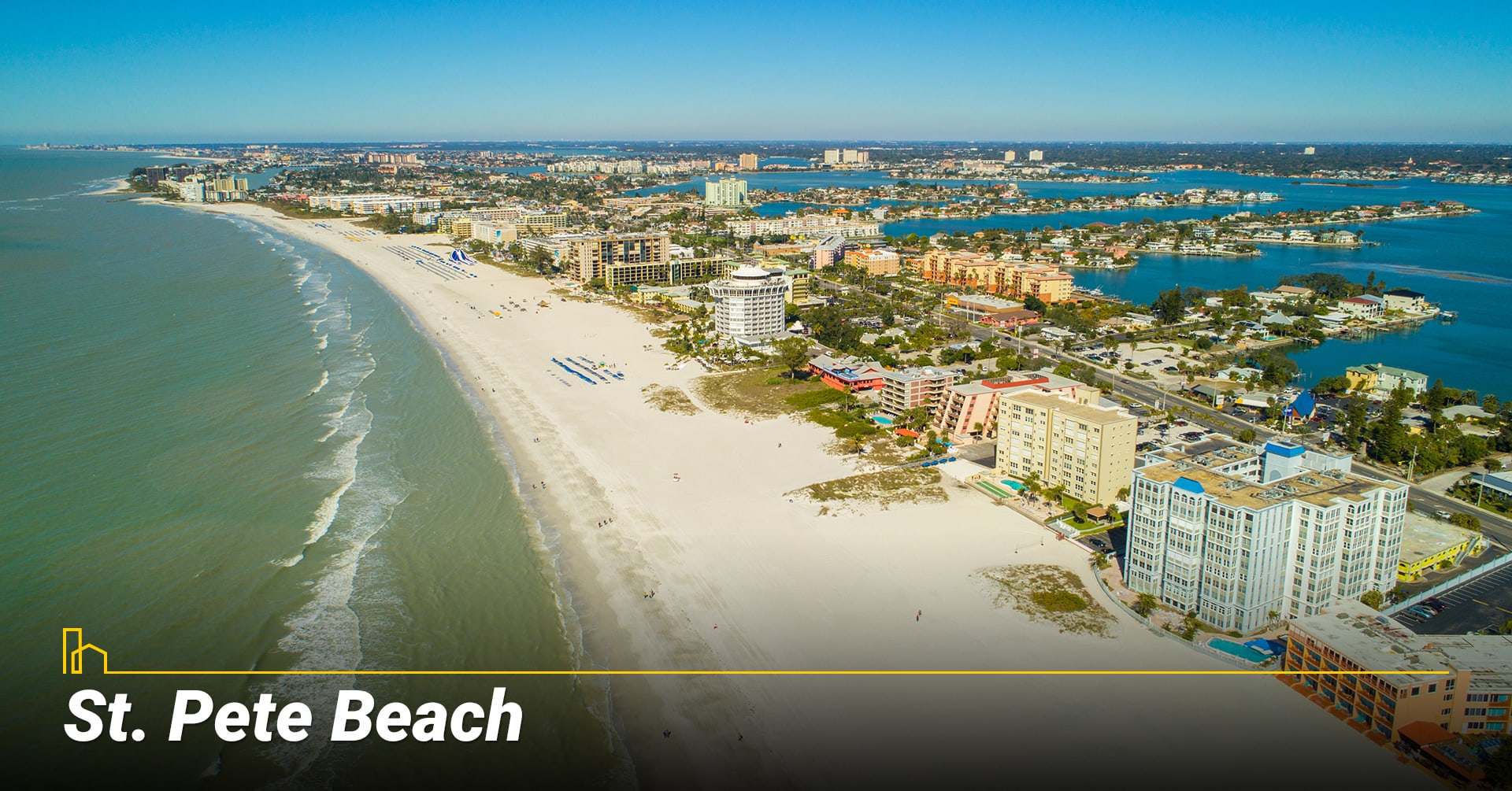
HOMEiA Score: 84/100
- Population: 8,879 | Rank Last Year: #7
- Cost of Living: 33.0% above the U.S. national average
- Home price to income ratio: $$484,700/$79,580 = 6.09 (buying homes is expensive)
- Income to rent ratio: $79,580/$14,604 = 5.45 (buying homes is expensive)
There is a barrier island located just off the coast of St Petersburg and Tampa Bay – this is where you can find St. Pete Beach! This is small area but boasts plenty of exciting views and things to do.
After leaving the island you’ll have access to Interstate 275, which runs through Tampa. Tampa International Airport is also close by if you are looking to travel. By moving to St. Pete Beach, you’ll experience literal “island life” for the rest of your days!
a. Size and Population
The population of St. Pete Beach is 9,587 and it has an area just under 7 square miles. The population density is 4,509 per square mile according to data from 2019.
The population increased by 2.6% from April 2010 to July 2019 which is below the overall U.S. rate of 6.3% – there’s still room for you!
In St. Pete Beach 36.1% of the population is over 65 years of age which is relativity high compared to 16.5% which is the national rate. The number of children is much lower, at only 7.7% of the population, compared to 22.3% nationally.
The population in St. Pete Beach has a much higher percentage of Caucasian inhabitants (93.6%), which is 23% higher than the US national average (76.3%) and 21% higher than the Florida average (77.3%). Be sure to keep this in mind when deciding on your move! If diversity is not an issue for you, then perhaps this would be a great place to live.
b. Median Income, Cost of Living and Housing Market Characteristics
The numbers below show the median income, cost of living and annual spending on housing for owned and rented properties in St. Pete Beach.
PETE BEACH MEDIAN HOUSEHOLD INCOME (2016-2022): $79,580
St. Pete Beach Cost of Living
- 30% Above the U.S. National Average
- 32% Higher than St. Petersburg, Florida
- 31% Lower than New York City, New York
- 22% Higher than Chicago, Illinois
St Pete Beach Housing Costs
| Median Home Value | Annual Spend for Homeowners | Annual Spend (Rent & Utilities) |
| $484,700 | $28,848 | $14,604 |
The home price to income ratio in St. Pete Beach is 6.04. This is based on the median home price of $462,500 and a median household income of $76,516. The U.S. average is 4.0 which means in general, it is expensive to buy homes in the area.
St. Pete Beach shows an income to rent ratio of 5.78. This is based on a median household income of $76,516 and an annual spend of $13,236. This means that it is very affordable to rent properties.
In St. Pete Beach, 75% of residents own their homes.
The 10 Key Factors to Know Before Moving to Florida
The Sunshine State has long been a state with appeal due to its year-round warm weather, endless coastline, and great communities within reach of the major cities. Whether you’ve done your research or are just getting started, it’s a good idea to consider these 10 things before moving to Florida…
Top Neighborhoods in St. Pete Beach, FL:
- Corey Avenue (Home Value Range: $125,000 to $600,000+)
Just outside of the main St. Pete Beach area, this neighborhood is the largest on the island. This option is great for those looking to meet tons of new people as there are plenty of families moving in nearby. - Three Palms Point (Home Value Range: $650,000 to $1.6 million+)
This community is small and almost entirely surrounded by water. With great views from any home, this area is great for anyone looking to enjoy their time on the water. - Brightwater Beach (Home Value Range: $250,000 to $2.5 million)
This area is a very small community on St. Pete Beach, well situated for sunset views. - Vina Del Mar Island (Home Value Range: $450,000 to $2.75 million)
With water views in all directions, this neighborhood is situated on a small island outside of the heart of St. Pete Beach.
c. Unique Attributes and Lifestyle
- Beaches and sunsets. St. Pete Beach is basically one large island, full of water views and beautiful shores in all directions. Bring a picnic to the beach and watch the sun set over the gulf – you really can’t miss it!
- Gulf Beaches Historical Museum. Check out this museum that features history and facts about different gulf beaches in Florida. This is a great weekend or day trip for the whole family.
- Bar hopping. Visit the 360 Rooftop, Harry’s Beach Bar, or Buoys Waterfront Bar and Grill. Check out the amazing views as you sip a delicious cocktail on the roof, looking out at the water, of course!
- Dog beaches. Visit Pass-A-Grille Dog Beach with your favorite furry friends! Let them run and explore the sand and water as they meet other canine pals.
d. Education
The University of South Florida is located about 65 miles south in Tampa if you’re looking for a more formal four-year college. If you want to take a few single courses in subjects that you are interested in, Pasco-Hernando State College is a great option to learn an array of new skills or subjects.
Between 2015 and 2019, the high school graduation rate in St. Pete Beach was significantly above the U.S. national average of 88%. The proportion of adults above 25 years of age with a college degree was also significantly above the national average.
e. Healthcare and Safety
Residents of St. Pete Beach typically travel the short distance to St. Petersburg when they need medical care. There are plenty of hospital such as St. Anthony’s Hospital. This facility is highly rated and has a variety of services available. According to HealthGrades.com, over 80% of patients would recommend this location – this is great if you are concerned about medical attention in your new community.
St. Pete Beach has 1.56 violent crimes per 1,000 residents which is significantly below Florida’s statewide median rate of 3.78 and the U.S. national median rate of 4.00. It also has 21.38 property crimes per 1,000 residents. This is about on-par with Florida’s statewide median of 21.46 and the U.S. national median of 21.00.
The 10 Cheapest Places to Live in Texas
They say everything is bigger in Texas, and for good reason. From some of America’s largest and active metropolitan cities to the host of recreational activities for people of all ages across the state to the many bigger-than-life personalities who call Texas home, Texas has plenty to offer for everyone. here’s the list of 10 lowest cost of living places…
8. Boca Raton
HOMEiA Score: 88/100
- Population: 97,422 | Rank Last Year: #4
- Cost of Living: 20.8% above the U.S. national average
- Home price to income ratio: $480,800/$84,445 = 5.69 (buying homes is expensive)
- Income to rent ratio: $84,445/$22,044 = 3.83 (renting homes is affordable)
There is a large coastal city located between Fort Lauderdale and West Palm Beach known as Boca Raton! This beautiful city is situated right off Interstate 95 making it a convenient home base for travel up and down the coast. Many drive to the Fort Lauderdale Airport when traveling out of state.
The name Boca Raton comes from the term “boca de ratones” which in Spanish means, “rat’s mouth.” This might seem odd, but the name refers to the sharp, pointed rocks that often fretted ships’ cables as they came near the coast- as if a rat was trying to eat their boat!
a. Size and Population
Boca Raton has a population of just under 100,000 and an area of just below 32 square miles. The population density is 3,420 per square mile according to data from 2019.
The population growth was above the national average between April 2010 and July 2019 at 18.2%. Boca Raton has a large proportion of seniors, with 26.8% of the population being over 65 years of age. In general, this is high compared to the U.S. as a whole (16.5%), but about on-average for Florida.
Conversely, only 16.8% of the population is less than 18 years old — typical for Florida, but less than in the U.S. overall, where 22.3% are minors.
b. Median Income, Cost of Living and Housing Market Characteristics
The numbers below show the median income, cost of living and the annual spending on housing for owned and rented properties in Boca Raton.
BOCA RATON MEDIAN HOUSEHOLD INCOME (2016-2022): $84,445
Boca Raton Cost of Living
- 21% Above the U.S. National Average
- 2% Lower than Miami, Florida
- 35% Lower than New York City, New York
- 13% Higher than Chicago, Illinois
Boca Raton Housing Costs
| Median Home Value | Annual Spend for Homeowners | Annual Spend (Rent & Utilities) |
| $480,800 | $30,156 | $22,044 |
The home price to income ratio in Boca Raton is 5.52. This number is based on the median home price of $458,600 and a median household income of $83,114. This tells us that, compared to the national average, it is generally expensive to buy homes in the area.
Boca Raton shows an income to rent ratio of 3.94, based on a median household income of $83,114 and an annual spend of $21,120. This means that it is affordable to rent properties!
In Boca Raton, 71.2% of residents own their homes.
The 10 Most Affordable Places to Live in Arizona
Arizona is world-renowned for its dramatic beauty, a combination of rugged mountains and vast desert landscapes. The sixth-largest state by area and the 14th largest in terms of population, Arizona is indeed beautiful–but it’s much, much more than that…
Top Neighborhoods in Boca Raton, FL:
- Royal Palm Yacht and Country Club (Home Value Range: $1.5 million to $20 million+)
This community is an extremely luxurious area with 24/7 surveillance. This community is ideal for those looking to live in one of the top private country clubs in South Florida. - Boca Bridges (Home Value Range: $1 million to $2.5 million+)
This community is very modern as far as design and features Spanish and Mediterranean-style homes. There are plenty of private amenities for those looking for things to do. - Lotus Boca Raton (Home Value Range: $1 million+)
This area is a gated community with modern floor plans and beautiful architecture situated throughout. Many homes also have gourmet kitchens and pristine landscaping. - Coventry a Boca Grove (Home Value Range: $300,000 to $600,000+)
This community is one of the smallest in the area with only about 30 homes. Golf and tennis courses are nearby for those looking for new activities!
c. Unique Attributes and Lifestyle
- Beaches. Visit the coastline for plenty of beaches and great views. Spanish River Park and Gumbo Limbo Nature Center are great for those looking to get some sun and sand.
- Boca Raton Museum of Art. Take a day trip to this local museum that features artists from across the world. You’ll never get board as there are plenty of rotating exhibits!
- Boomers Boca Raton. This amusement park is great fun for the whole family. With arcade games, go-karts, mini-golf, bumper boats and food, the whole family can spend hours at this hidden gem.
- Parks. Sugar Sand Park, Spanish River Athletic Park, Pondhawk Natural Area and Sand Pine Park are all great places to visit if you need to get out of the house. With playgrounds for kids and short trails, these locations are great for anyone.
d. Education
Florida Atlantic University is in Boca Raton and has plenty of classes and full programs for those interested in education. There are a few smaller schools in the area, such as Lynn University and Everglades University. This area is situated in a great place if you are prioritizing education in the future. Smaller schools offer tons of courses from experts in a variety of areas.
The high school graduation rate in Boca Raton between 2015 and 2019 was significantly above the U.S. national average of 88%. The proportion of adults above 25 years of age with a college degree was also significantly above the national average.
e. Healthcare and Safety
The main hospital in this area is called The Boca Raton Regional Hospital. They have about 400 beds and specialize in a variety of areas, such as cardiovascular health, oncology, women’s health, and orthopedics. According to HealthGrades.com, over 75% of patients would recommend this location.
Boca Raton has 2.07 violent crimes per 1,000 residents which is below Florida’s statewide median rate of 3.78 and the U.S. national median rate of 4.00. It also has 23.27 property crimes per 1,000 residents which is above Florida’s statewide median of 21.46 and the U.S. national median of 21.00.
CONCLUSION
Florida is an incredibly diverse state that has plenty to offer in terms of where you can retire! Move to a quiet beach community on the coast or one of the fastest growing retirement communities in the nation. Experience warm weather for most of the year and choose from different leisurely activities to fill your days.
Don’t worry about the grandkids not coming to visit – Disney’s not going anywhere!
7 Best Small Towns to Live in Texas
We present 7 smaller cities that are great for professionals, retirees, and families with children. Incidentally, they also happen to be places that I have enjoyed visiting with family and friends over the decades. In our examination, we’ll prioritize things that may be more important for families who prefer not to live in heavily urbanized areas…
